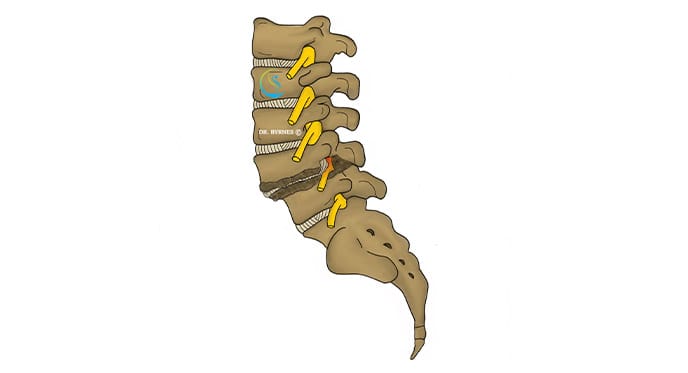
Spondylolisthesis is a condition in which one of the vertebrae of the spine "slips" forward in relation to another. Spondylolisthesis is usually degenerative developing in part from facet joint arthropathy. There are other underlying causes of Spondylolisthesis including a mechanical bony defect (Spondylolysis / Pars Defect) resulting in the slip. Non-surgical treatment can involve muscle strengthening exercise. Surgery is often needed to realign and fuse the bones
The vertebrae of the spine are attached their adjacent vertebrae through a disc in the front and 2 facet joints at the back. The upper facet joint and the lower facet joint are connected by a narrow bridge of bone called the pars interarticularis. Severe arthritic change in the facet joint or a defect within the pars interarticularis can result in back pain and a bony slip or Spondylolisthesis.
The pars defect can occur on one of both sides and at almost any level within the spine however it is most commonly seen in the lower lumbar spine.
Typical symptoms include low back pain and also sciatica (radiating leg pain with or without associated numbness. Leg pain will often be more severe when standing or walking.
Mild cases of spondylolysis and spondylolisthesis can cause relatively minor pain and can initally be managed with therapeutic exercise. These conditions are often found incidentally when a person has an X-ray or scan for an unrelated problem.
The most common cause of the bony slip (spondylolisthesis) in older adults is degenerative osteoarthritis of the facet joints leading to incompetence of these joint and progressive slippage of the bones at that level.
The underlying cause of spondylolysis (pars defect) may be an inherent weakness of the pars interarticularis with a defect present at birth or occurring through injury in youth. Repeated mechanical loading the pars in certain sports or activities can lead to a stress fracture of the pars and high energy traumatic fractures also occur.
Those who played sports in youth, especially young gymnasts and young children who injure their lower backs are more likely to develop spondylolysis and spondylolisthesis. The condition is often only recognised later in life when symptoms of back and leg pain develop.
A careful medical exam will attempt to determine the type and cause of your spine problem and the treatment options. A diagnostic evaluation includes a medical history and physical exam. Often imaging scans (e.g., x-ray, CT, MRI) and tests to check muscle strength and reflexes are used.
